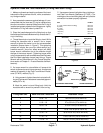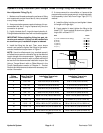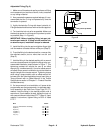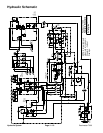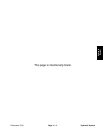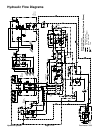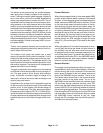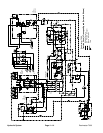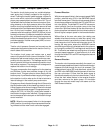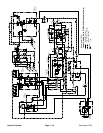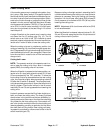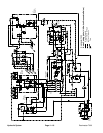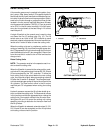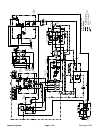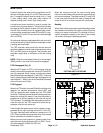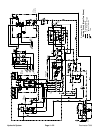
Reelmaster 7000 Hydraulic SystemPage 4 -- 15
Traction Circuit: Transport Speed (2WD)
The traction circuit piston pump is a variable displace-
ment pump that is directly coupled to the engine fly-
wheel. Pushing the traction pedal engages a hydraulic
servo valve which controls the variable displacement
piston pump swash plate to create a flow of oil. This oil
isdirected tothe frontwheeland rearaxle motors.Oper-
ating pressure on the high pressure side of the c losed
traction circuit loop is determined by the amount of load
developedatthe fixeddisplacementwheeland axlemo-
tors. As the load increases, circuit pressure can in-
creasetorelief valvesettings:5000PSI(345 bar)inboth
forward and reverse. If pressure exceeds the relief set-
ting, oil flows through therelief valve to the low pressure
sideoftheclosedlooptractioncircuit.Thetractioncircuit
provides operation in either mow speed (4WD) or trans-
port speed (2WD).
Traction circuit pressure (forward and reverse) can be
measured at test portslocated on the traction circuit hy-
draulic tubes of the machine.
The traction circuit pump and motors use a small
amount of hydraulic fluid for internal lubrication. Fluid is
designed to leak across traction pump and motor com-
ponents into the case drain. This leakage results in the
lossofhydraulic fluidfromthe closedlooptraction circuit
that must be replaced. The charge circuitis designed to
replace this traction circuit leakage.
The gear pump section that supplies oil to the steering
and lift/lower circuits also provides charge oil for the
traction circuit. This gear pump is driven directly off the
tractionpump.It providesaconstant supplyofcharge oil
to the traction circuit to make up for oil that is lost due to
internal leakage in the traction pump and motors.
Charge pump flow is directed through the oil filter andto
the low pressure side of the closed loop traction circuit.
A filter bypass valve allows charge oil flow to the closed
loop if the filter becomes plugged. Charge pressure is li-
mited to 207 PSI (14.3 bar) by a relief valve located in
the filtration/charge control manifold. Charge pressure
can be measured at the test port on the filtration/charge
control manifold.
NOTE: When the mow speed limiter is in the transport
(2WD) position, the cutting units are prevented from be-
ing lowered and the mow circuit cannot be engaged.
Forward Direction
Withthemowspeedlimiterinthetransportspeed(2WD)
position, solenoid valve (SV) in the 4WD/2WD control
manifold is energized.The solenoid valve spoolshifts to
direct chargepressure that shifts the PD1 andPD2 con-
trol valve spools. The shifted PD1 and PD2 valves pre-
vents hydraulic flow from the piston pump to the rear
axle motor. With flow blocked to the rear axle motor, all
piston pump flow is directedto the front wheel motors to
allow a higher transport speed in the forward direction.
Without flow to the rear axle motor, the rotating rear
wheels drive the axle motor so it acts like a pump. Inlet
oil to the axlemotor is provided by a check valve that al-
lows charge circuit oil intothe rear axle motor circuit. Oil
leaving the axle motor enters the 4WD/2WD control
manifold at port M2 and is directed back to the axle mo-
tor through the shifted PD1 cartridge and manifold port
M1. To allow for rearwheel loop cooling when in forward
transport speed operation, a small amount of oil exits
through the shifted PD1 and PD2cartridges that returns
to the reservoir.
Reverse Direction
The traction circuit operates essentially the same in re-
versetransport speedas itdoes in theforward direction.
However, the flow through the circuit is reversed. The
shifted solenoid valve (SV) and directional valves PD1
and PD2in the 4WD/2WDmanifold preventoil flowfrom
the rear axle motor. Oil flow from the piston pump is
thereforedirected toonly thefront wheelmotors. Thisoil
drives the front wheel motors in the reverse direction
and then returns to the piston pump. Oil circulation
through the rear axle motor loop is the same as in the
2WD forward direction.
Hydraulic
System



